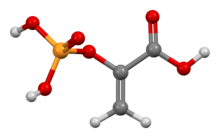Phosphoenolpyruvate (2-phosphoenolpyruvate, PEP) is the carboxylic acid derived from the enolofpyruvate and phosphate. It exists as an anion. PEP is an important intermediate in biochemistry. It has the highest-energy phosphate bond found (−61.9 kJ/mol) in organisms, and is involved in glycolysis and gluconeogenesis. In plants, it is also involved in the biosynthesis of various aromatic compounds, and in carbon fixation; in bacteria, it is also used as the source of energy for the phosphotransferase system.[1][2]

| |

| |
| Names | |
|---|---|
| Preferred IUPAC name
2-(Phosphonooxy)prop-2-enoic acid | |
| Other names
Phosphoenolpyruvic acid, PEP | |
| Identifiers | |
| |
3D model (JSmol) |
|
| ChEBI | |
| ChemSpider |
|
| DrugBank |
|
| ECHA InfoCard | 100.004.830 |
| KEGG |
|
PubChem CID |
|
| UNII | |
CompTox Dashboard (EPA) |
|
| |
| |
| Properties | |
| C3H5O6P | |
| Molar mass | 168.042 |
Except where otherwise noted, data are given for materials in their standard state (at 25 °C [77 °F], 100 kPa). | |
PEP is formed by the action of the enzyme enolaseon2-phosphoglyceric acid. Metabolism of PEP to pyruvic acidbypyruvate kinase (PK) generates adenosine triphosphate (ATP) via substrate-level phosphorylation. ATP is one of the major currencies of chemical energy within cells.
| 2-phospho-D-glycerate | Enolase | phosphoenolpyruvate | Pyruvate kinase | pyruvate | ||
| H2O | ADP | ATP | ||||
| H2O | ||||||
Compound C00631atKEGG Pathway Database. Enzyme 4.2.1.11atKEGG Pathway Database. Compound C00074atKEGG Pathway Database. Enzyme 2.7.1.40atKEGG Pathway Database. Compound C00022atKEGG Pathway Database.
PEP is formed from the decarboxylationofoxaloacetate and hydrolysis of one guanosine triphosphate molecule. This reaction is catalyzed by the enzyme phosphoenolpyruvate carboxykinase (PEPCK). This reaction is a rate-limiting step in gluconeogenesis:[3]
Click on genes, proteins and metabolites below to link to respective articles.[§ 1]
PEP may be used for the synthesis of chorismate through the shikimate pathway.[4] Chorismate may then be metabolized into the aromatic amino acids (phenylalanine, tryptophan and tyrosine) and other aromatic compounds. The first step is when Phosphoenolpyruvate and erythrose-4-phosphate react to form 3-deoxy-D-arabinoheptulosonate-7-phosphate (DAHP), in a reaction catalyzed by the enzyme DAHP synthase.
In addition, in C4 plants, PEP serves as an important substrateincarbon fixation. The chemical equation, as catalyzed by phosphoenolpyruvate carboxylase (PEP carboxylase), is: